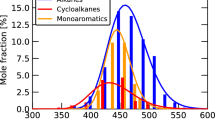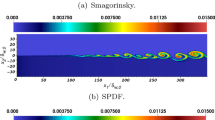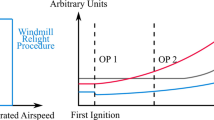Abstract
A hybrid probabilistic model was developed and used to investigate a generic scramjet engine at flight conditions (Mach 8, 30 km altitude). To assess the robustness of the design, uncertainties in boundary conditions and modelling were considered. The full-system model is composed of three parts, which were modelled separately: inlet with isolator, combustion chamber and nozzle. The inlet and the nozzle were resolved using two-dimensional calculations solving the Reynolds averaged Navier Stokes equations, while the combustion chamber modelling was based on an one-dimensional stream tube approach. Flight properties and injection parameters were considered aleatoric in nature. Uncertainties introduced by different averaging approaches at the model interface were presumed to be epistemic. The uncertainties were propagated using probabilistic collocation if feasible and Monte Carlo simulation if necessary. The more recent probabilistic collocation approach allows a reduction of the necessary number of evaluations. Hence, a more detailed model can be employed. However, as this polynomial chaos approach is only valid for smooth transformations, it fails to predict singular hazardous events, e.g. discontinuities such as thermal choking of the combustor. To consider these events, a Monte Carlo simulation had to be applied. The hybrid model and the full probabilistic collocation model showed equivalent results. But the hybrid model acquired additional information at overall lower calculation expanses.









Similar content being viewed by others
Abbreviations
- \(\beta \) :
-
Nozzle thrust vector (–)
- \(\gamma \) :
-
Ratio of specific heats (–)
- \(\delta \) :
-
Boundary layer height (m)
- \(\zeta \) :
-
Vector of random variables (–)
- \(\eta \) :
-
Efficiency (–)
- \(\Theta \) :
-
Angle (\(\circ \))
- \(\mu \) :
-
Mean value
- \(\rho \) :
-
Density (kg/m\(^3\))
- \(\sigma \) :
-
Standard deviation
- \(\sigma ()\) :
-
Variation coefficient (–)
- \(\phi \) :
-
Base of random variables (–)
- b :
-
Width (m)
- c :
-
Expansion coefficients (–)
- F :
-
Net Force (N)
- f :
-
Factor for Pulsonetti correlation (–)
- h :
-
Height (m)
- l :
-
Length (m)
- Ma :
-
Mach number (–)
- M :
-
Standard normal distributed random variable (–)
- n :
-
Number of Samples (–)
- P :
-
Degree of Polynomial Chaos expansion (–)
- p :
-
Pressure (Pa)
- r():
-
Correlation coefficient (–)
- r :
-
Recovery factor (–)
- T :
-
Temperature (K)
- u :
-
Random variable (–)
- v :
-
Velocity (m/s)
- w :
-
Mass fraction (–)
- x, y, z :
-
Coordinates (m)
- \(\mathbf {X}\) :
-
Vector of random variables (–)
- 0:
-
Ambient conditions
- \(\infty \) :
-
Infinity value
- c:
-
Combustion
- central:
-
Central injector position
- i:
-
Control variable
- inj:
-
Injector
- L:
-
Lift direction
- mix:
-
Mixing
- rel:
-
Reliability
- T:
-
Thrust direction
- t,tot:
-
Total
- var:
-
Variables
- w:
-
Wall
- wall:
-
Wall injector position
- AoA:
-
Angle of attack
- CFD:
-
Computational fluid dynamics
- CI:
-
Central injector
- CMES:
-
Conserved mass/energy/entropy method
- CMME:
-
Conserved mass/momentum/energy method
- ER:
-
Equivalence ratio
- Lang:
-
Langley distortion methodology
- LHS:
-
Latin Hypercube Sampling
- Mawe:
-
Mass flux-weighting
- PCM:
-
Probabilistic collocation method
- QoI:
-
Quantities of interest
- RANS:
-
Reynolds averaged Navier Stokes Equations
- SERN:
-
Single expansion ramp nozzle
- WI:
-
Wall injector
References
Baurle, R., Gaffney, R.: The art of extracting one-dimensional flow properties from multi-dimensional data sets. In: 45th AIAA Aerospace Sciences Meeting and Exhibit (2007). https://doi.org/10.2514/6.2007-639
Eldred, M.S., Giunta, A.A., Brown, S.L., Adams, B.M., Dunlavy, D.M., Eddy, J.P., Gay, D.M., Griffin, J.D., Hart, W.E., Hough, P.D., Kolda, T.G., Martinez-Canales, M.L., Swiler, L.P., Watson, J.P., Williams, P.J.: Dakota, a multilevel parallel object-oriented framework for design optimization, parameter estimation, uncertainty quantification, and sensitivity analysis—version 6.4 reference manual (2016)
Fuhrmann, T.: Auslegung und Betriebsverhalten von SCRamjet-Antriebssystemen für Raumtransporter-Hyperschallflugzeuge: Techn. Univ., Diss.–München, 2009, 1. aufl. edn. Luftfahrt. Verl. Dr. Hut, München (2009)
Gerhold, T., Galle, M., Friedrich, O., Evans, J.: Calculation of complex three-dimensional configurations employing the dlr-tau-code. In: 35th Aerospace Sciences Meeting and Exhibit (06 January 1997–09 January 1997). https://doi.org/10.2514/6.1997-167
Gerlinger, P., Möbus, H., Brüggemann, D.: An implicit multigrid method for turbulent combustion. Journal of Computational Physics 167(2), 247–276 (2001). https://doi.org/10.1006/jcph.2000.6671
Goodwin, D.G., Harry K. Moffat, Raymond L. Speth: Cantera: An object-oriented software toolkit for chemical kinetics, thermodynamics, and transport processes (2016)
Häberle, J., Gülhan, A.: Investigation of two-dimensional scramjet inlet flowfield at mach 7. Journal of Propulsion and Power 24(3), 446–459 (2008). https://doi.org/10.2514/1.33545
Hannemann, K., Karl, S., Martinez Schramm, J., Steelant, J.: Methodology of a combined ground based testing and numerical modelling analysis of supersonic combustion flow paths. Shock Waves 20(5), 353–366 (2010). https://doi.org/10.1007/s00193-010-0269-8
Heiser, W.H., Pratt, D.T.: Hypersonic airbreathing propulsion. AIAA education series. American Institute of Aeronautics and Astronautics, Washington, D.C (1994)
Hirschen, C.M., Gruhn, P., Gülhan, A.: Influence of heat capacity ratio on the interaction between the external flow and nozzle flow of a scramjet. In: 14th AIAA/AHI Space Planes and Hypersonic Systems and Technologies Conference (2006). https://doi.org/10.2514/6.2006-8095
Hosder, S., Bettis, B.: Uncertainty and sensitivity analysis for reentry flows with inherent and model-form uncertainties. J. Spacec. Rockets 49(2), 193–206 (2012). https://doi.org/10.2514/1.A32102
Hosder, S., Walters, R., Balch, M.: Efficient sampling for non-intrusive polynomial chaos applications with multiple uncertain input variables. In: 48th AIAA/ASME/ASCE/AHS/ASC Structures, Structural Dynamics, and Materials Conference (23 April 2007–26 April 2007). https://doi.org/10.2514/6.2007-1939
Huan, X., Safta, C., Sargsyan, K., Geraci, G., Eldred, M., Vane, Z., Lacaze, G,. Oefelein, J., Najm, H.,: Global Sensitivity Analysis and Estimation of Model Error, Toward Uncertainty Quantification in Scramjet Computations. AIAA J. 56(3), 1170–1184 (2018). https://doi.org/10.2514/1.J056278
Johnson, D.L.: Terrestrial environment (climatic) criteria guidelines for use in aerospace vehicle development. 2008 revision (2008)
Karl, S., Laurence, S., Martinez Schramm, J., Hannemann, K.: Cfd analysis of unsteady combustion phenomena in the hyshot-ii scramjet configuration. In: 18th AIAA/3AF International Space Planes and Hypersonic Systems and Technologies Conference (2012). https://doi.org/10.2514/6.2012-5912
Kliche, D., Mundt, C.: Progress in multidisciplinary analysis and evaluation of supersonic combustion ramjets. In: 17th AIAA International Space Planes and Hypersonic Systems and Technologies Conference (2011). https://doi.org/10.2514/6.2011-2281
Krause, M., Ballmann, J.: Numerical simulations and design of a scramjet intake using two different rans solvers. In: 43rd AIAA/ASME/SAE/ASEE Joint Propulsion Conference & Exhibit (2007). https://doi.org/10.2514/6.2007-5423
Langener, T., Steelant, J., Roncioni, P., Natale, P., Marini, M.: Preliminary performance analysis of the lapcat-mr2 by means of nose-to-tail computations. In: 18th AIAA/3AF International Space Planes and Hypersonic Systems and Technologies Conference (2012). https://doi.org/10.2514/6.2012-5872
Loeven, G.J.A., Witteveen, J.A.S., Bijl, H.: Probabilistic collocation: An efficient non-intrusive approach for arbitrarily distributed parametric uncertainties. In: 45th AIAA Aerospace Sciences Meeting and Exhibit (2007). https://doi.org/10.2514/6.2007-317
Mack, A., Hannemann, V.: Validation of the unstructured dlr-tau-code for hypersonic flows. In: 32nd AIAA Fluid Dynamics Conference and Exhibit (24 June 2002–26 June 2002). https://doi.org/10.2514/6.2002-3111
Mantis, G.C., Mavris, D.N.: A bayesian approach to non-deterministic hypersonic vehicle design. In: World Aviation Congress & Exposition, SAE Technical Paper Series. SAE International400 Commonwealth Drive, Warrendale, PA, United States (2001). https://doi.org/10.4271/2001-01-3033
Mcbride, B.J., Gordon, S.: Computer program for calculating and fitting thermodynamic functions (1995)
Meiss, J.H., Schröder, W., Meinke, M.: Numerical investigation to enhance the thrust vector of a scramjet nozzle. In: 17th AIAA International Space Planes and Hypersonic Systems and Technologies Conference (2011). https://doi.org/10.2514/6.2011-2346
Menter, F.R., Kuntz, M., Langtry, R.: Ten years of industrial experience with the sst turbulence model. Turbul. Heat Mass Transf. 4, 625–632 (2003)
Miller, D.S.: Internal flow systems, BHRA Fluid Engineering Series, vol. 5. BHRA Fluid Engineering, Cranfield (1984)
National Oceanic and Atmospheric Administration, National Aeronautics and Space Administration, U. S. Air Force: U.s. standard atmosphere (1976)
Ogawa, H., Alazet, Y., Pudsey, A., Boyce, R., Isaacs, A., Ray, T.: Full flow-path optimization of axisymmetric scramjet engines. In: 17th AIAA International Space Planes and Hypersonic Systems and Technologies Conference (2011). https://doi.org/10.2514/6.2011-2347
Pulsonetti, M., Erdos, J., Early, K.: An engineering model for analysis of scramjet combustor performance with finite rate chemistry. In: 24th Joint Propulsion Conference (11 July 1988–13 July 1988). https://doi.org/10.2514/6.1988-3258
Scheuermann, T., Chun, J., Wolfersdorf, J.V.: Experimental investigations of scramjet combustor characteristics. In: 15th AIAA International Space Planes and Hypersonic Systems and Technologies Conference (28 April 2008–01 May 2008). https://doi.org/10.2514/6.2008-2552
Scheuermann, T., Chun, J., Wolfersdorf, J.V.: One-dimensional modelling of a scramjet combustor reacting flow. In: 15th AIAA International Space Planes and Hypersonic Systems and Technologies Conference (28 April 2008–01 May 2008). https://doi.org/10.2514/6.2008-2643
Schütte, G., Staudacher, S.: Probabilistic aspects of scramjet design. J. Propuls. Power 25(2), 281–288 (2009). https://doi.org/10.2514/1.38195
Sobol, I.M.: Sensitivity estimates for nonlinear mathematical models. Math. Modell. Comput. Exp. 1993(14), 407–414 (1993)
Tang, G., Iaccarino, G., Eldred, M.S.: Using stochastic expansion methods in evidence theory for uncertainty quantification. In: 51st AIAA/ASME/ASCE/AHS/ASC Structures, Structural Dynamics, and Materials Conference (2010). https://doi.org/10.2514/6.2010-2589
Vellaramkalayil, J.J., Scheuermann, T., Wolfersdorf, J.V.: Analysis of a two-staged supersonic combustion chamber using experiments and simulations. In: 17th AIAA International Space Planes and Hypersonic Systems and Technologies Conference (2011). https://doi.org/10.2514/6.2011-2247
Weigand, B., Gaisbauer, U.: An overview on the structure and work of the dfg research training group grk 1095: ’aero-thermodynamic design of a scramjet propulsion system’. In: 16th AIAA/DLR/DGLR International Space Planes and Hypersonic Systems and Technologies Conference (2009). https://doi.org/10.2514/6.2009-7276
Witteveen, J.A.S., Duraisamy, K., Iaccarino, G.: Uncertainty quantification and error estimation in scramjet simulation. In: 17th AIAA International Space Planes and Hypersonic Systems and Technologies Conference (2011). https://doi.org/10.2514/6.2011-2283
Xiu, D.: Numerical methods for stochastic computations: a spectral method approach. Princeton University Press, Princeton (2010)
Acknowledgements
The present work was created as part of the Research Training Group GRK1095/2. The authors want to thank the German Research Foundation (DFG) for providing financial support.
Author information
Authors and Affiliations
Corresponding author
Rights and permissions
About this article
Cite this article
Feil, M., Staudacher, S. Uncertainty quantification of a generic scramjet engine using a probabilistic collocation and a hybrid approach. CEAS Aeronaut J 9, 649–659 (2018). https://doi.org/10.1007/s13272-018-0303-6
Received:
Revised:
Accepted:
Published:
Issue Date:
DOI: https://doi.org/10.1007/s13272-018-0303-6




